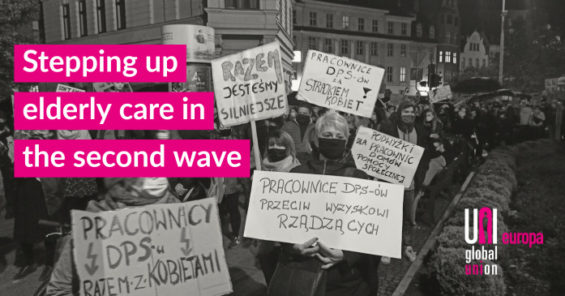
The people I interviewed are employees of long-term care institutions. Although these are mainly homes for the elderly, they also provide care for disabled people of different ages. This group of participants includes people who have direct contact with the residents of the facilities: carers, nurses, housekeepers, physiotherapists. This group also includes people who do not work directly with the residents, but whose work is necessary for the functioning of the institutions, such as cooks or receptionists.
We came into contact with this group through the COZZ ‘Care’ campaign – organising workers in the care sector. Within the framework of this campaign, two structures/organisations were set up – one for workers in private care centres belonging to a large multinational company, the other for workers in public centres (called ‘Dom Pomocy Spolecznej’). This division is due to the institutional order of the sector in our country. It also influences the nature of the group participating in the Involve project – I would like to have approximately the same number of people from the private and public sectors in the research group.
What is the difference between the two groups?
The public DPSs are mostly staffed by older women. The whole sector is very feminised. The facilities are severely underfunded and wages are at the national minimum. Because salaries are so low, there are not many people willing to work. As a result, the staff rarely changes and consists mainly of long-term female employees (which is why the average age is quite high). There is a strong sense of mission in this group, which motivates the staff.
In private institutions, which are growing dynamically, the staff is much more diverse. There are more young women, and quite a few migrant women. Salaries are higher than in the public sector, but still not commensurate with the responsibilities and pressures faced by female workers. Many women workers there are on temporary contracts.
What do these two groups have in common?
Despite their differences, what female workers in both the public and private sectors have in common is work overload combined with understaffing. Working in care homes is very hard, both physically and emotionally. Then there is the lack of respect from employers and residents’ families, which is a common experience.
***
I have conducted six interviews so far, three at the end of 2023, another three in February and March of 2024. The interviews lasted between 1h30m and 2h10. The feedback was good, the questions were understandable. Interviewees said they felt comfortable. Three interviews were conducted in our organisation’s office, which is an ideal location (comfortable and no one disturbed us). Two was conducted in a café near the home of one of the participants. And one in public library which was also very fit. Despite my concerns about interviews in cafes, the interviews went very well.
All 6 participants are trade union activists in the sense that they are formally members of a trade union. Trade union activism is a specificity of the group we work with as the Central European Organising Centre. However, among the potential participants in the Involve project there will be people with varying degrees of involvement. I expect that the majority of participants will be trade unionists, but I would like the group of participants to be diverse in this respect.
Marcin Marszalek
More information: Marcin.Marszalek@cozz-uni.org
